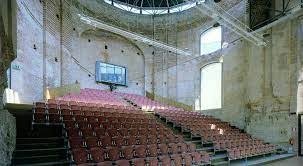Venues

Conference venue & Ceremony for the Signature of the Magna Charta
Aula Absidale Santa Lucia – Via de’ Chiari 25a
Created from a 17th century deconsecrated church, Aula Santa Lucia was refurbished in 1988 on the occasion of the celebrations of the 9th centennial of the founding of the University of Bologna.
Today this elegant building is a prestige venue for high level meetings and functions.

World Café Tables Sessions
&
Gala Dinner
Palazzo Pepoli - Museum of the History of Bologna - Via Castiglione 8
The first nucleus of the building was built in 1344 by Taddeo Pepoli, combining several properties of the family purchased in Strada Castiglione by his father Romeo. Taddeo initially made it an austere building protected by a moat and drawbridges, with a stately home inside, a noble courtyard, scenic staircase, reception hall, and rich and sumptuous stucco decorations. Under a crenelated cornice, a band of black and white squares is still painted, arranged in a checkerboard pattern as in the Pepoli coat of arms.
In 1360 the Holy See confiscated the building assigning it to the Apostolic Chamber which made it the seat of the Gregorian College. Starting from 1474 the building returned to the hands of the Pepoli family who increased it for centuries.
The last wing was built in 1723.
In 1887 Ferdinando Pepoli, the last male member of the family, sold the central portion of the building to the Trapani count Agostino Pepoli, of the Sicilian branch of the family.
After his death, which took place on 23 March 1910, the Municipality of Bologna, according to the testamentary disposition, had as a legacy his portion of the building via Castiglione at numbers 6, 8, and 10, with everything contained therein including the collection of objects of art from the first piano, on condition that the Municipality opens it to the public for the establishment of a Pepoli Museum.
The municipality, on the other hand, in 1913 transferred the Pepoli library to the municipal library and sold the building the following year to the local Cassa di Risparmio, which had acquired the remaining parts from other private individuals. In the 1930s it underwent restoration.
The palace is now the seat of the Museum of the History of Bologna.

Lunches
Cloister of San Giovanni in Monte - Piazza San Giovanni in Monte 3
The San Giovanni in Monte Complex is a historical 16th century monastery building (1543) that still today overlooks the bordering portion of the old town centre of Bologna from the artificial "hill". A former monastery of the Order of Canons Lateran, it was thoroughly restored at the end of the 1990s and streamlined again after its use as a prison between the age of Napoleon until 1984.
The restoration was a cultural revisiting of its function as place of study and meditation, which the monastery building acquired for the city during the Renaissance age. The large cloister, called "Doric" or "old", a sort of magnificent foyer onto the church square of San Giovanni in Monte that is open to the city, is extremely impressive. The 16th century executions include the large refectory, which today is the Giorgio Prodi Lecture Hall, an official hall where Bartolomeo Cesi's fresco depicting the parable of the royal wedding taken from a passage from the Gospels, Matthew 22, stands in centre stage.
However, the history of the building is much older as, based on tradition, the complex was built in the 5th century by the bishop Petronius for the purpose of symbolically depicting the places and paths of the Passion of Christ. Nevertheless, many clues lead to the hypothesis that the older substratum was formerly the site of a public building of the Augustan age, placed at the border of the Roman city, but strategically situated in a high position overlooking the access of Via Aemilia from the east.
Source: portal of Alma Mater Studiorum - University of Bologna